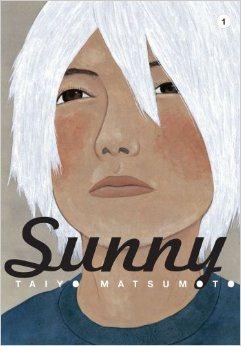 Title: Sunny
Title: Sunny
Genre: Slice-of-Life, Drama
Artist: Taiyo Matsumoto
Publisher: SHOGAKUKAN (JP), VIZ (US)
Serialized in: IKKI
Translation: Michael Arias
Original Release Date: May 21, 2013
There’s nothing sunny about Sunny. The title isn’t referring to the series’ disposition, though. It’s a nod to one of the most important settings for the orphans and abandoned kids of the Star Kids Home–the broken-down Nissan Sunny that sits in the yard, a no-adults-allowed reprise from the ugly grown-up world where the kids take turn escaping into their personal fantasies. These first few volumes are an exploration of childhood and the painful transition into adulthood, a mixture of melancholia and nostalgia balanced by moments both heart-breaking and heart-warming.
Sunny is one of the more recent titles released by VIZ Signature, a line targeted at more mature audiences. This line is tied in with the SIGIKKI magazine also released by VIZ, which is an English adaptation of the Japanese magazine IKKI, famous for serializing alternative and underground works. The VIZ Signature line typically takes a little more care in the production and packaging of its releases, and that holds true with Sunny. Encased in a hardcover binding, Sunny has thicker, better quality paper than the usual paperback manga, and colored pages at the beginning of each volume. The packaging obviously has collector’s appeal, but it also elevates the mood of the reader before the book is even opened. It seems to announce that even though Sunny is about a bunch of kids, there’s nothing juvenile about the stories it tells.
That’s an impression that immediately asserts itself in the first few pages of Sunny as well. We are immersed in the world of Star Kids Home without any introduction or explanation, but none is really needed to understand the frenetic energy and chaos so often associated with childhood. The playful moments lack all the usual appeal of nostalgia, though. There’s anxiety and pent-up frustration seething under their surface that never goes away. It’s easiest to see it when the new kid, Sei, is dropped off at the home. His quiet, persistent denial of reality is pushed up against the loud and obnoxious behavior of the veteran kids at the home like Junsuke and Haruo, who face their situation with anger and violence. Sei tries hard to remove himself from his surroundings, in ways that are more painful than Haruo’s or Junsuke’s constant attempts to assert their existence. At the end of his first day at Star Kids Home, Sei sits in the driver’s seat of the Sunny, imagining himself driving home, and it’s the rawness of the moment, the way he has memorized the directions and buildings on the way to his parents’ house, that delivers a sharp, emotional punch to the readers. It’s a nostalgia that makes you want to cringe or look away because facing the truth of the moment is too difficult. And that’s what Sunny does over and over to its readers.
Sunny is a mish-mash of moments, some sweet and some sad, that switch from character to character. While some of the moments are more overstated and forced than others, such as one scene when Megumu has an existential crisis when she discovers the dead body of a stray cat floating in the river, more often than not these moments build upon one another and translate into subtle consequences later on. As in the case of the cat, Megumu later develops a habit of glancing into the river to check for dead things, something that escapes the primary focus of the panels but nonetheless delivers a painful impact for the readers who understand where that behavior comes from.
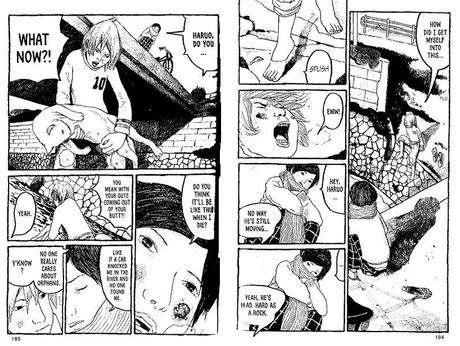
The first volume of Sunny serves as more or less an introduction to the characters, and in volume two we see more of their histories and personal struggles. Interspersed between these rather difficult moments, though, are picturesque pages like the one below that exude a more positive flavor of nostalgia and show that, even though the kids at Star Kids Home have to face some harsh realities, they are still normal kids. What’s more is that these glimpses into the daily life at Star Kids Home illustrate the family dynamic that develops between all the people there–it has a comfy feel, a sense of normalcy, and provides a stability that can be hard to find among the rest of the volume’s challenging moments.
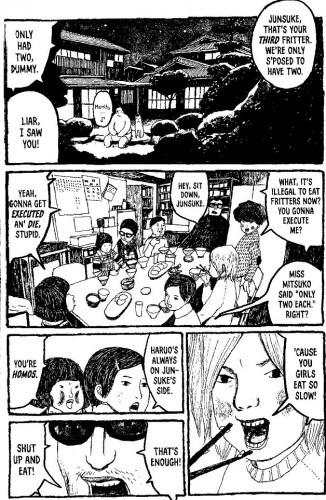
One of the hardest chapters occurs at the end of the volume when Haruo visits his mother. In volume one, Haruo expressed his dislike at spending time with his mom–he hates the fear and sadness that inevitably assault him at the end of the visit and dreads having to say good-bye to her. However, it’s impossible to ignore Haruo’s giddy excitement at being with his mom. He tries desperately to please her, but it’s underscored by the quietness only the readers can pick up on from the sudden change in behavior and it speaks to a reserved sadness that Haruo keeps to himself.
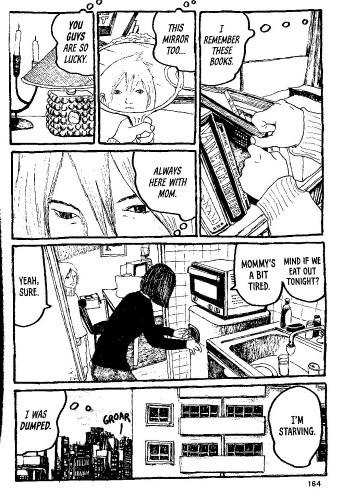
It’s painful to watch as Haruo tries to put the pieces back together, to fabricate the life he once had with his mom in order to restore a sense of order and normalcy to his life. But the facade he tries to create doesn’t last. In one of the most visceral scenes in the series so far, his pent-up anger explodes when he’s confronted with his mother’s nonchalance. Even though his mother never tells us how she feels about her son, we can see it plain as day. We see it in the way she barely looks up from her newspaper as her son has an emotional breakdown, we see in the way she buys him a sackful of Nivea lotion–a sort of security blanket Haruo carries around with him to remind him of her smell–as a substitute for her role as a mother, and we see it when she tells him to stop calling her mom and call her by her first name. We see it, and most importantly, we feel it, and we feel for Haruo despite his attempts to bury his feelings and forget them.
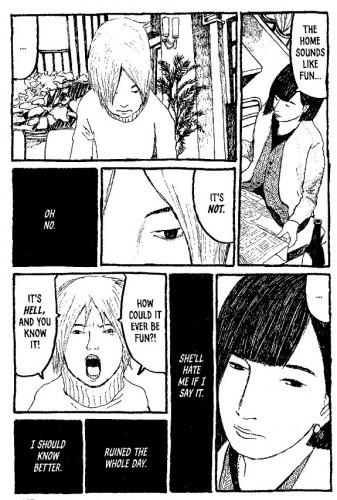
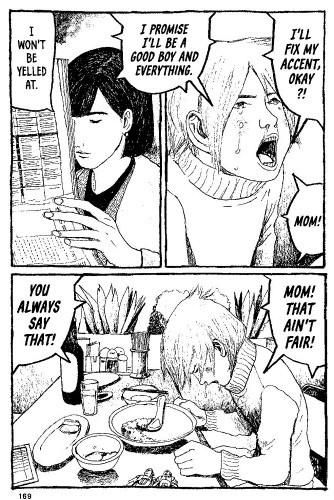
Volume three is concerned mostly with the juxtaposition of childhood and adulthood, choosing to look to the future rather than the past. But we quickly find that the future can be just as hopeless as the present and past for the kids at Star Kids Home. Makio, the grandson of the housemaster, is a recent college graduate that is aimlessly searching for his purpose in life, and despite having a functional family, he fits right in with the kids at Star Kids Home. His family puts a lot of pressure on him to find a job, and his girlfriend makes a seamless transition from college grad to working professional, which creates a rift in their relationship. Makio seems just as left behind as the kids at Star Home Kids, filled with the same sense of anxiety and frustration at the real world, and proves that Sunny has just as much to say about adulthood as it does about childhood.
It’s the similarity in mindset between the children and adults in the series that emerges as one of the most poignant features of the series. Sei, who has faced his share of challenges at the home, finally seems to be breaking down. His attempts at making friendships and meaningful relationships fail at every turn–when a new kid came to the home, Sei took him under his wing because he understood the difficulty in making the transition and felt like their similarities could balance the burden of being at the home, but in no time Taro’s mother returns to take him home, and Sei is left with wounds new and old opened raw. But we don’t understand just how desolate Sei’s condition is until we witness a private moment at the end of the volume. Haruo has released a herd of pigs destined for the slaughterhouse, and the kids are in charge of rounding them back up. Sei finds the last one napping under a tree and feels a strange affinity to the pig’s hopeless future.
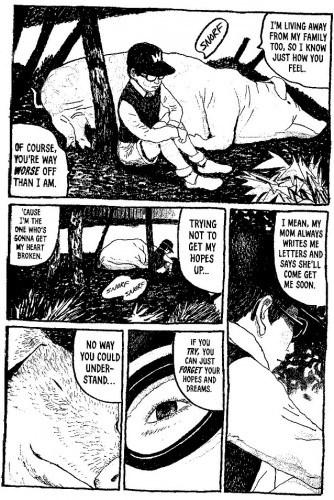
Later, Haruo tells Sei that he released the pigs so that they could experience freedom before they were slaughtered. In classic Haruo style, he asserts that if he had been one of the pigs, he would have never let himself get caught. And that’s one of the more enduring aspects of the series–the sense of freedom provided by childhood, and the fact that the kids at Star Kids Home never got that experience. It gives an unnerving, slightly uncomfortable atmosphere to a series where setting and mood exist as secondary characters. And despite the bleak outlook for the kids at the home, their perseverance and determination is inspiring and one can’t help but to cheer each and every one of them on.
Sunny is a complex read, one that warrants a slow pace and repetition to understand all it has to offer. The imagery and messages imparted by Taiyo Matsumoto are powerful and have a tendency to get under your skin and aren’t easily shaken off. The image of the Nissan Sunny is one that will stick with its readers long after the books are closed–and, much like the personal fantasies that are played out in the car’s interior, this is a journey that you take with your mind.
 Title: Sunny
Title: Sunny
